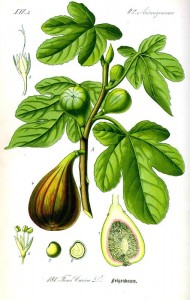ANNALS OF FOOD HISTORY
I don’t give a fig.
Actually, I do. In my Washington D.C. neighborhood near Dupont Circle, a stump sits where a once vital tree had stood, a sad sight. The tree, planted by Italian-born barber Diego D’Ambrosio near his shop, had fruited last summer. (The block on which his business is located was designated by the city as “Diego D’Ambrosio Way” four years ago.) Diego’s fig tree, like many in the Northeast, had suffered because of the unusually frigid winter. In New York City, where many trees had been planted in ethnic neighborhoods like Carroll Gardens, Bensonhurst, and Astoria, the New York Times reported, the toll has been especially heavy.
Ethnic Italians, lovers of the fig, must have been especially disheartened by the condition of the trees. Reminders of home, the trees have long been planted in their back yards by immigrants in New York and other cities. That this hardy Mediterranean plant and its luscious fruit could bloom in what seemed like an inhospitable setting made it all the more desirable. Ingenious gardeners found ways of shielding their trees from the cold. “People took a lot of pride in the ritual of wrapping their trees,” arborist Christopher Roddick told the Times.
Fig planting, I realized, was one more example of the Italian penchant for growing food from their homeland. I had recently been investigating how “giardinieri,” Italian truck farmers, had introduced artichokes to Northern California. Artichoke cultivation burgeoned into a commercial enterprise. But as fig gardening demonstrated, there were countless nostalgic ethnics who produced grapes, fennel, and basil simply for their own enjoyment.
Perhaps some writer has recorded this story of the fig’s transplanting. The hints we have of this journey suggest that there is a fascinating tale to be told. Italian immigrants, the writer Michele Scicolone observed in a New York Times interview, “could take a branch from a fig tree back home, let it go dormant during the long boat journey, then plant it when they got here, and it would grow.”
Reading about this winter’s fig casualties teased my curiosity. It was a fruit I only knew bits and pieces about. If it was strange to me, a writer digging into food history, the fig must be even more alien to many others.
How had a fruit so cherished by the ancients escaped wider recognition and appeal today? As I browsed through writings about the plant, I discovered how strong a hold the fruit had on the spirits and imagination of earlier civilizations.
The fig was ripe for symbolism and myth, an absorbing book, The Realm of Fig and Quince, reveals. Written by Dutch author Ria Loohuizen and published by Prospect Books, a distinguished English food book publisher, the volume tells us that the fig was the “sacred fruit of the lustful and ever-thirsty god Dionysus.” In another piece of delicious lore, Loohuizen notes that Plato was known as philosykos, or fig lover.
Thanks to this book, I will never think of the word sychophant in the same way. Since the fig was sacred, the story goes, the Athenians barred its export. People who told authorities of illicit fig sales were therefore known as sukophanti, or fig informers (from sukon, or fig, and phainein, reveal). Samuel Coleridge, the English poet whom Loohuizen quotes, made sure his readers knew how he was using the word: “I use ‘sycophant’ in its original sense, as a wretch who flatters the prevailing party by informing against his neighbors, under pretence that they are exporters of prohibited figs.”
The fig also lent itself to a variety of sexual associations. D.H. Lawrence was one of many writers whose erotic fancies it stirred:
Every fruit has its secret.
The fig is a very secretive fruit.
As you see it standing growing, you feel at once it is symbolic:
And it seems male.
But when you come to know it better, you agree with the Romans, it is female.
And there is, of course, the fig wasp, an insect crucial to the reproduction of many varieties of the fruit. But more about that curiosity at another time.
August 2014









